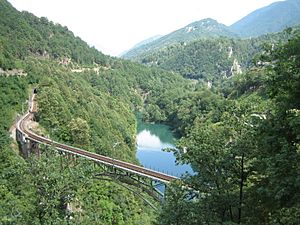Lago di Palagnedra facts for kids
Quick facts for kids Lago di Palagnedra |
|
|---|---|
 |
|
| Location | Ticino |
| Coordinates | 46°9′34″N 8°37′37″E / 46.15944°N 8.62694°E |
| Type | reservoir |
| Primary inflows | Melezza |
| Primary outflows | Melezza |
| Catchment area | 137.7 km2 (53.2 sq mi) |
| Basin countries | Switzerland |
| Surface area | 0.25 km2 (0.097 sq mi) |
| Water volume | 4,260,000 m3 (150,000,000 cu ft) |
| Surface elevation | 486 m (1,594 ft) |
Lago di Palagnedra is a special kind of lake called a reservoir. It is located near a place called Palagnedra in Ticino, which is a part of Switzerland. This reservoir holds a lot of water, about 4,260,000 cubic meters! Its surface area is about 0.25 square kilometers.
Contents
Exploring Lago di Palagnedra
Lago di Palagnedra is not a natural lake. It was created by building a dam across a river. This makes it a reservoir. Reservoirs are very important because they can store water for many uses.
What is a Reservoir?
A reservoir is like a big, artificial lake. People build dams across rivers to create them. These dams stop the river's flow and collect water behind them. Reservoirs are used for many things. They can provide drinking water for towns and cities. They also help control floods by holding back excess water. Sometimes, the water from reservoirs is used to generate electricity. This is called hydroelectric power.
Where is Lago di Palagnedra Located?
This interesting reservoir is found in the region of Ticino in Switzerland. Switzerland is a country in Europe known for its beautiful mountains and lakes. Ticino is a southern part of Switzerland. It is known for its Italian-speaking culture and stunning landscapes. The lake is fed by a river called the Melezza. The Melezza River also flows out of the reservoir.
Facts and Figures About the Lake
Lago di Palagnedra sits at an elevation of about 486 meters (or about 1,594 feet) above sea level. Even though it's not a huge lake, its volume of water is quite impressive. The water in the reservoir comes from a large area around it, which is called its catchment basin. This basin covers about 137.7 square kilometers.

